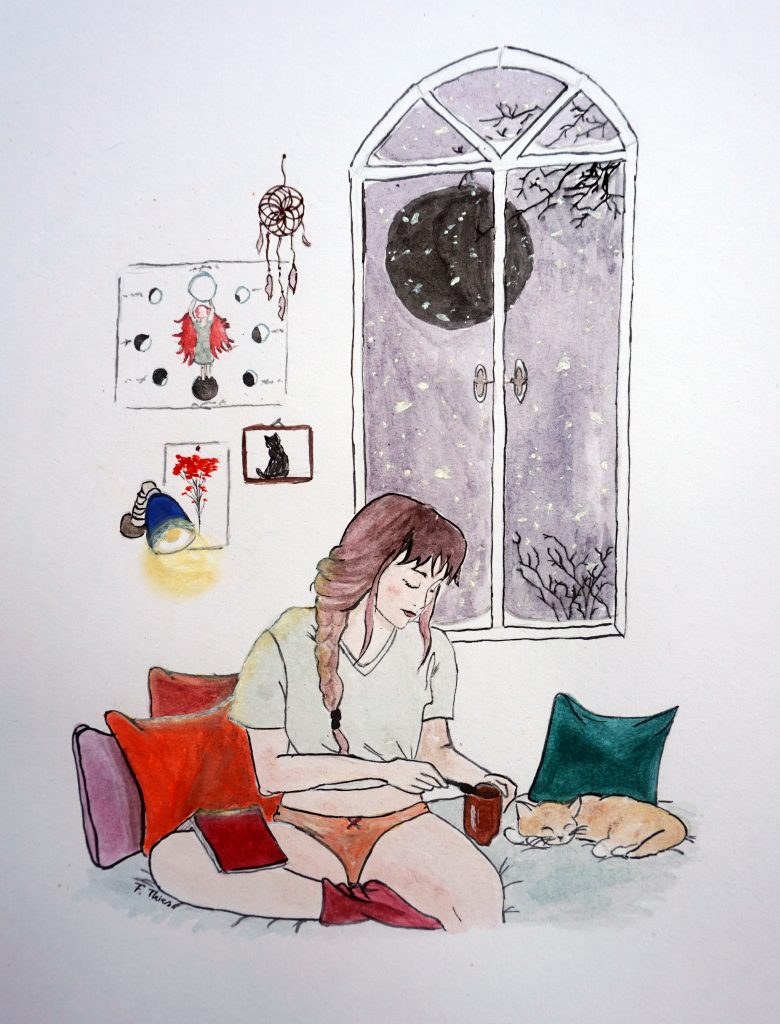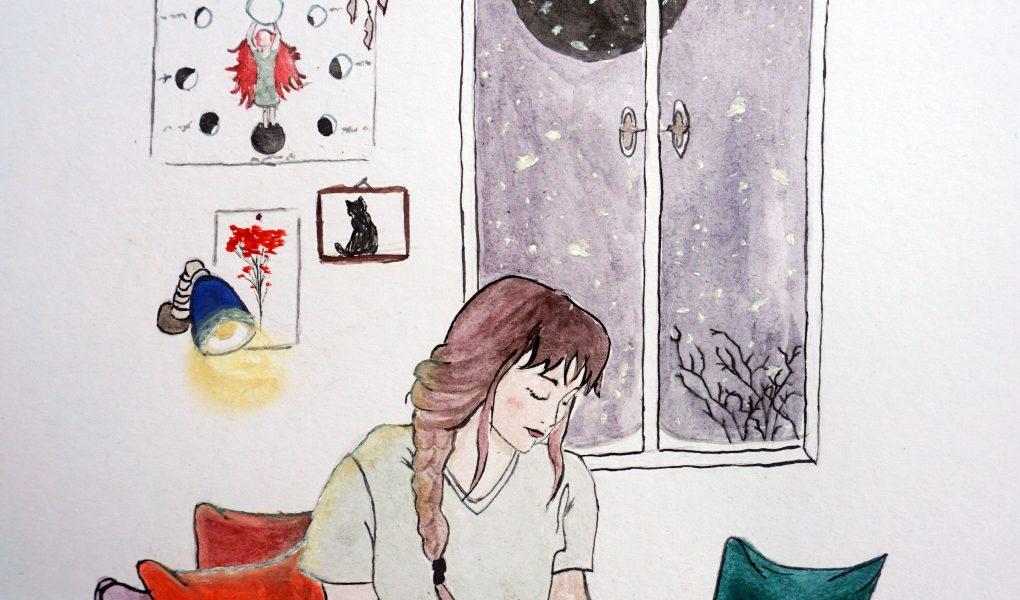
Three years ago I did a post called „6 Mood Boosters for Fall“ aimed at changing the perspective towards the colder season. But I really wanted to address the meat of the issue and talk about the root of seasonal depression, also known as Seasonal Affective Disorder (SAD), and effective tools and methods that really help. As someone who used to be heavily affected by it and now learned to ride the waves, I figure I am the perfect source of information to help you to navigate it as well. So, let’s dive right into it.

What is Seasonal Depression? – A physical perspective
In my own words, seasonal depression is comprised of a multitude of factors with the main issue being the decrease of sunshine hours. The rays of the sun are, as far as we know today, made up of different frequencies: infrared light, ultraviolet light, UV-A radiation and UV-B radiation. All of these have different effects on the body.
UV-B radiation triggers the body to produce vitamin D3. Vitamin D is responsible for a healthy immune system and works as a mood stabilizer. Furthermore, it controls the calcium absorption and the synthesis of some important proteins in the body. In the winter months, the flat solar incidence angle is not sufficient to trigger this process effectively. This effect is even weaker when you have highly-melanated skin and live in a northern region like Norway.
Another important factor is Melatonin. Melatonin controls the day-night-rhythm of the human body. Darkness increases, brightness slows down the production of melatonin – thus the melatonin release reaches its peak in the early morning hours. In winter, when daylight is reduced both in duration and intensity, melatonin levels remain elevated during the day. As a result, fatigue, sleep disorders and even seasonal depression can occur.
The second contributor: Emotional associations
These are the main physical effects of lack of sunlight, that then also have an effect on the emotional and mental wellbeing. From my personal experience however, emotional associations also shouldn’t be ignored. This could be particular traumas from childhood that, without remembering them, you experienced with the ending of summer or in the colder season. For example, many only children experienced an increasing lack of relationships in winter because the colder seasons meant less socialization, while siblings were often better able to cushion this fall. Even festivities like Christmas can be triggering factors if you did not have very fulfilling experiences with them as a child. Thus, in addition to the diminishing exposure to the sun, trauma associations and social factors such as fewer gatherings are also worth a look. These are of course very personal, but often you intuitively know which of them might apply to you.

Tools that really help – think multi-angle
Physical Relief
To attain relief on a physical level, there are two things that I find to be the most effective:

1 Fill up your tank in summer. Vitamin D3 storage works like a tank as it is saved in the body and accessed when needed. Because, in all honesty, our body is fucking smart. If we would not sit in offices all day, it would be amazingly prepared for winter. So, get your sunlight hours in summer to prep for winter.
2 The right kind of supplements. In my opinion just taking vitamin d3 supplements by your go-to pharmaceutical company is not really doing it. They would never admit it, but they are making money of people not being in a perfect state of health 😉. Often highly-isolated molecular structures are being used that lack the enzymes to properly digest it. Furthermore, from a medical perspective, vitamin K is needed to fully absorb vitamin D. So make sure the supplements you take are from an independent company that takes these factors into consideration.
One example would be “Sonnenvitamine” (sun vitamins) by a German company called AlphaFoods. Now beware, this is not a product placement. I personally use them and am confident in their use. Not only are the capsules vegan and the production is sustainable with European suppliers and a statement against the use of palm oil. They also contain a 4.000 unit of vitamin D3, making use of the tank-function I described earlier, meaning you can take one capsule every four days. On top of that, they contain omega-3 fatty acids from algae and vitamin K2 all-trans (instead of cis or MK4) so your body can fully absorb the benefits.
3 Using UV-Lamps. As I stated earlier, melatonin levels stay elevated during winter daytime. This causes us to feel tired and unmotivated. Therapy with UV-lamps is something I find to be extremely helpful as a remedy. You can work with the lamp anytime between getting up to about 7pm, but using it first thing in the morning is the most effective. You will feel more awake, motivated and much lighter. In order to protect your eyes it is vital to follow the manufacturer’s instructions.
Emotional Relief
Relief on the emotional level might seem a bit more „vague“, if you are used to a physical approach only. But in my opinion these are just as effective.
1 The power of color. As most of you might guess, the nuances of yellow, from a sunwarm yellow down to a creamy white, are the closest in the color spectrum you can get to the sentiment of joy. I highly recommend getting bedsheets in varying nuances of yellow, or decorating your house with this in mind.
2 Hacking the happiness chemicals. There are four main chemicals responsible for mental, emotional and physical wellbeing. Learn how to trigger their production and take your wellbeing into your own hands.

a Dopamine is an important messenger substance in the brain (neurotransmitter). It is all about reward as it effects our motivation and drive. Compared to serotonin, dopamine has a longer-term motivational and drive-enhancing effect. How to raise it? Do what you want to do! Sounds simple, but it is the most natural way to raise your dopamine level again. If you haven’t had a sense of achievement for a while, your body forgets the feedback effect of the hormone that drives you to achieve your goals. Another important factor is proper nutrition. Especially foods that are high in omega-3 fatty acids are important for your dopamine production. Omega-3 fatty acids are responsible for the function and structure of the brain and are found vegan e.g. in algae oil, chia seeds or hemp oil.
b Oxytocin means „quick birth“ in ancient Greek. Therefore, it is no surprise that for decades it was known mainly as a contraction hormone. Oxytocin plays a major role in the coexistence of all humans. It has a prosocial effect, i.e. it promotes positive social interaction. Oxytocin can, for example, strengthen the bond between couples, build trust in other people and reduce stress, fear and aggression. If you are in a romantic relationship you have a clear advantage here. If not, any social interaction that involves touch will trigger the production of oxytocin, whether its cuddling pets, holding babies, or hugging your grandmother. If you don’t have access to these, try volunteering for an animal shelter. Where I live, you can take out dogs on weekend days without any commitments to spend some time with them.
While I seem to have good access to Dopamine and Oxytocin, the following two are my personal construction sites:
c Serotonin is a neurotransmitter in the peripheral and central nervous system and is often called the mood stabilizer. 95% of serotonin is found in the gastrointestinal tract, 90% of it in the cells of the intestinal mucosa and the remaining 10% in the enteral nervous system. This illustrates how important a healthy digestive tract is for our mental health and vice versa. Serotonin is involved in the following processes, among others: Sensation of pain, Memory performance, Sleep control, Eating behaviour, Sexual behaviour, Thermoregulation. To raise serotonine, think of „stabilizing“ activites. This means for sport, anything involving endurance, like running, is best. Also going into nature or meditating triggers the production of the neurotransmitter.
Cocoa also contains serotonin. The concentration increases during fermentation and decreases during roasting. For this reason, dark chocolate can increase the serotonin level. However, it also contains carbohydrates in the form of sugars, which can signal the body to produce more serotonin. The effect of eating sweets on serotonin levels is rather short-lived and lasts only one to two hours. The best way would therefore be cocoa in its raw form, e.g. served as a drink with a naturally sweet plant milk like oat.
d Endorphins – Have you ever experienced that rush during sports when you think nothing works anymore and suddenly you have a real energy boost? Endorphins, short for „endogenous morphines“, are morphines produced by the body itself, which have a pain-relieving effect and are part of the body’s own opioid system. Probably the most fundamental effect of endorphins is therefore the alleviation of pain and the mood-lifting effect. Other effects include improved sleep, reduction of stress, strengthening of the immune system and the production of sex hormones. The best remedy for a healthy endorphin level? LAUGH. Watch comedies, let yourself be tickled, even artificial laughter lifts your spirits after a while.
Emotional Healing
Work with the emotional root of seasonal depression. While physical and emotional relief are symptom treatments, it is far more effective to work on the emotional root of the issue. Any kind of presence process will help with this. A presence process helps you to dive into your pain and then resolve it forever. It is like changing the past. Trauma continues to live inside of us like in a loop or a skipping CD. So, anything that helps you to resolve stuck trauma parts, will increase your overall wellbeing for good.
If you don’t know where to start, here is a demonstration of such a presence process, you can do at home by yourself:
Lastly, I feel you. I know the pain. You are not crazy. There is nothing wrong with you.
If you struggle with seasonal depression, consider bookmarking this blog. This way you can keep coming back to it.
I hope winter is gentle to you this year. Love, Frauke ♥






[…] is usually made from cocoa mass and cocoa butter. In my blog about seasonal depression I have already talked about how cocoa produces long-term serotonin after fermentation. However, […]